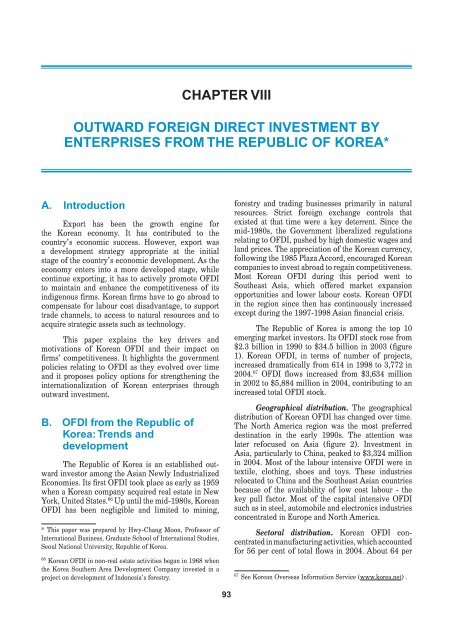Global Players from Emerging Markets: Strengthening ... - Unctad
Global Players from Emerging Markets: Strengthening ... - Unctad
Global Players from Emerging Markets: Strengthening ... - Unctad
You also want an ePaper? Increase the reach of your titles
YUMPU automatically turns print PDFs into web optimized ePapers that Google loves.
CHAPTER VIII<br />
CHAPTER VIII 93<br />
OUTWARD FOREIGN DIRECT INVESTMENT BY<br />
ENTERPRISES FROM THE REPUBLIC OF KOREA*<br />
A. Introduction<br />
Export has been the growth engine for<br />
the Korean economy. It has contributed to the<br />
country’s economic success. However, export was<br />
a development strategy appropriate at the initial<br />
stage of the country’s economic development. As the<br />
economy enters into a more developed stage, while<br />
continue exporting, it has to actively promote OFDI<br />
to maintain and enhance the competitiveness of its<br />
indigenous firms. Korean firms have to go abroad to<br />
compensate for labour cost disadvantage, to support<br />
trade channels, to access to natural resources and to<br />
acquire strategic assets such as technology.<br />
This paper explains the key drivers and<br />
motivations of Korean OFDI and their impact on<br />
firms’ competitiveness. It highlights the government<br />
policies relating to OFDI as they evolved over time<br />
and it proposes policy options for strengthening the<br />
internationalization of Korean enterprises through<br />
outward investment.<br />
B. OFDI <strong>from</strong> the Republic of<br />
Korea: Trends and<br />
development<br />
The Republic of Korea is an established outward<br />
investor among the Asian Newly Industrialized<br />
Economies. Its first OFDI took place as early as 1959<br />
when a Korean company acquired real estate in New<br />
York, United States. 66 Up until the mid-1980s, Korean<br />
OFDI has been negligible and limited to mining,<br />
* * This This paper paper was was prepared prepared by by Hwy-Chang Hwy-Chang Moon, Professor of<br />
International International Business, Business, Graduate Graduate School School of of International International Studies,<br />
Studies,<br />
Seoul Seoul National National University, University, Republic Republ Republic ic of of Korea.<br />
Korea.<br />
66 Korean OFDI in non-real estate activities began in 1968 when<br />
the Korea Southern Area Development Company invested in a<br />
project on development of Indonesia’s forestry.<br />
93<br />
forestry and trading businesses primarily in natural<br />
resources. Strict foreign exchange controls that<br />
existed at that time were a key deterrent. Since the<br />
mid-1980s, the Government liberalized regulations<br />
relating to OFDI, pushed by high domestic wages and<br />
land prices. The appreciation of the Korean currency,<br />
following the 1985 Plaza Accord, encouraged Korean<br />
companies to invest abroad to regain competitiveness.<br />
Most Korean OFDI during this period went to<br />
Southeast Asia, which offered market expansion<br />
opportunities and lower labour costs. Korean OFDI<br />
in the region since then has continuously increased<br />
except during the 1997-1998 Asian financial crisis.<br />
The Republic of Korea is among the top 10<br />
emerging market investors. Its OFDI stock rose <strong>from</strong><br />
$2.3 billion in 1990 to $34.5 billion in 2003 (figure<br />
1). Korean OFDI, in terms of number of projects,<br />
increased dramatically <strong>from</strong> 614 in 1998 to 3,772 in<br />
2004. 67 OFDI flows increased <strong>from</strong> $3,634 million<br />
in 2002 to $5,884 million in 2004, contributing to an<br />
increased total OFDI stock.<br />
Geographical distribution. The geographical<br />
distribution of Korean OFDI has changed over time.<br />
The North America region was the most preferred<br />
destination in the early 1990s. The attention was<br />
later refocused on Asia (figure 2). Investment in<br />
Asia, particularly to China, peaked to $3,324 million<br />
in 2004. Most of the labour intensive OFDI were in<br />
textile, clothing, shoes and toys. These industries<br />
relocated to China and the Southeast Asian countries<br />
because of the availability of low cost labour - the<br />
key pull factor. Most of the capital intensive OFDI<br />
such as in steel, automobile and electronics industries<br />
concentrated in Europe and North America.<br />
Sectoral distribution. Korean OFDI concentrated<br />
in manufacturing activities, which accounted<br />
for 56 per cent of total flows in 2004. About 64 per<br />
67 See Korean Overseas Information Service (www.korea.net) .

















